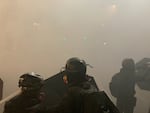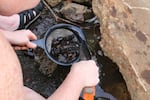
A neighborhood enveloped in thick smoke from tear gas canisters disturbed local residents during the 121st night of protests for racial justice in Portland on Tuesday, Oct. 6, 2020.
Sergio Olmos
Portland has entered a fifth straight month of street protests, often met with a barrage of police-deployed crowd-control munitions, making Portland the most tear-gassed city in America.
This has environmental groups, public health and human rights advocates questioning the short- and long-term effects of tear gas — not just on those demonstrating for racial justice, but also on the environment.
There is no shortage of information and research about what tear gas exposure does to the human body. The Oregon Health Authority and the Department of Environmental Quality share information on their website from the Centers for Disease Control and Prevention (CDC), where the agency lists health effects from riot control agents or tear gas.
But the answers become much murkier when it comes to what those chemical agents do to the environment.
The lack of such information is at the heart of a federal lawsuit filed Tuesday by environmental and civil rights groups. They’re seeking an end to the use of tear gas and other chemical munitions by the Department of Homeland Security, alleging it failed to assess the environmental impact and to take other steps required under the National Environmental Policy Act.
Related: Lawsuit accuses Homeland Security of violating environmental law with Portland tear gas deployment
On Sept. 10, Portland Mayor Ted Wheeler banned the police force from using CS gas, a form of tear gas that creates clouds of smoke filled with chemicals often used by Portland police and federal officers to disperse protesters. The ban came after more than 100 days of continuous demonstrations but still allows city police to use other types of non-lethal irritants, including OC gas, pepper spray and targeted munitions like pepper balls.
Duke University’s Sven Eric Jordt has been researching the biological effects of tear gas and how it affects the nervous system since the 2014 Black Lives Matter protests in Ferguson, Missouri. He said he’s concerned about what the residual effects from the chemicals will have in a city environment.
“Also the fact that we don’t know what kind of chemicals are produced when the tear gas is burned and dispersed in the streets, right,” Jordt said. “What we then wash off and what we don’t know, what’ve have not detected yet.”
So far in Portland, the only official findings on the environmental impact of tear gas have come from the city’s Bureau of Environmental Services. In response to complaints and reports of people power washing the streets sending residue down the storm drains, the agency collected samples of tear gas residue from the downtown area and tested it during the summer.
The lawsuit against the Department of Homeland Security also alleges BES' sampling from August was inadequate as too few locations were tested before determining there was no significant environmental impact.
Tear gas residue and the Willamette River
In August, the Bureau of Environmental Services cleaned out six storm drains in downtown Portland near Mark O. Hatfield U.S. Courthouse and Lownsdale Square, considered the epicenter of protests. The city agency took samples from each storm drains to test for pollutants and chemicals associated with tear gas.
“We’re always concerned about new sources of pollution and that’s why we acted to sample those storm drains and to clean them out,” Portland Bureau of Environmental Services spokesperson Diane Dulken said.
A month later the agency concluded the amount of pollutants found in the samples like barium, copper, lead, and zinc from the storm drains did not pose an immediate threat to the environment.
Although some pollutants were found at an elevated level, the agency said it was within normal levels of what’s found in stormwater before it reached the Willamette River.
Other pollutants like cyanide were detected in the sediment from all catch basins. Perchlorate was also detected in both stormwater and sediment samples with the highest concentration located on the west corner of Southwest 3rd Avenue and Salmon Street.

Scientist Juniper Simonis sifts through sediment outside of a culvert on the west bank of the Willamette River near the U.S. Immigration and Customs Enforcement building in Portland, Ore.
Monica Samayoa / Monica Samayoa
Now, the agency has been monitoring where tear gas has been deployed in other parts of the city. On Sept. 17, the agency cleaned out 11 storm drains located around the Immigration and Customs Enforcement (ICE) building in South Portland on Macadam Avenue but will not be taking any more samples.
All 11 storm drains located in this area lead directly to the Willamette River.
The BES’s conclusion that enough sampling and testing has been done on munitions residue entering the environment has been echoed by other state agencies, including the Oregon Health Authority, and Oregon Health and Science University.
Risking lives for more answers
On the west bank of the Willamette River near the ICE building, aquatic ecologist Juniper Simonis secured themself to a rope tied to a nearby tree and climbed down a steep bushy hill full of thorns. Simonis navigated sharp, slippery and steep rocks to get close enough to a culvert to collect water samples.
“I know from my background, a lot of the chemicals that are included in these chemical weapons munitions that law enforcement are using are detrimental to ecological systems, detrimental to other organisms as well as to humans,” Simonis said. “So, what I am particularly interested in is understanding how what gets used up there impacts the organisms down here.”
Simonis is the lead scientist at DAPPER Stats, a Portland-based ecological consultant company. Simonis also has a doctorate in ecology and evolutionary biology from Cornell University.
Simonis has been attending demonstrations and collecting munitions as they are dispersed by authorities, to test later for chemicals.
In September, Simonis shared research and results from those samples, as well as from soil, tree foliage and other items taken from different areas from the city. Those test results have identified gaseous zinc chloride from hexachloroethane (HC), which is also found in the smoke grenades used by federal officers in July.
Right now, Simonis' main focus is collecting samples from two different culverts on the Westbank of the Willamette River, one near the ICE building and the other near the Hawthorne Bridge. Simonis has been sifting through sediment from the river to look for munitions that have made it through the storm drain system.
Simonis said the munitions found in the river present a much bigger problem for the environment as it is a more concentrated packet of the toxic chemicals.
“So rather than being dissolved in the water and more diluted, it’s a very concentrated dose,” they said.

Scientist Juniper Simonis climbs down the west bank of Willamette River to take samples from a outside of a culvert near the U.S. Immigration and Customs Enforcement building in Portland, Ore., on Oct. 16, 2020.
Monica Samayoa
Police-fired rubber bullets and pepper balls that wash down storm drains and into the river create other issues for fish and the ecosystem, Simonis said, because they are around the same size of what fish eat in the river.
Simonis expects more munitions to show up as the rain begins to fall, washing them into the river from storm drains and bioswales.
“These things that are being pumped down into the river right now are full of heavy metals that bioaccumulate. We’re talking about zinc, we’re talking about lead, we’re talking about aluminum, we’re talking about chromium,” they said. “Really gnarly stuff that isn’t just going to move through the ecosystem and move on, it’s going to stay here and it’s going to impact the river and people for generations.”
More research needed
The limited research available on the potential environmental impacts of tear gas residue are creating questions for far-away observers like Duke’s Jordt.
“It’s a solid powder that is dispersed in this fog and then eventually deposits on the ground,” Jordt said. “If you don’t wash it off it can stay there for quite a while or blown into buildings, apartments or people have it in their clothing or their cars and then we don’t know where it ends up and it could cause long term problems.”
From an environmental safety perspective, he said it’s good that city work crews have been power washing tear gas residue in highly hit areas — although that raises questions about where it goes.
Jordt said the detection of even low or normal concentrations of chemicals like cyanide or perchlorate in the sediment or in the Willamette River would be concerning. He said the city should be sending people in during protests to collect more samples, including air samples, in areas where the tear gas is being deployed — something that has persisted into fall.
Over the weekend, federal officers deployed tear gas and pepper ball munitions at nearly 100 protesters outside of the ICE building in southwest Portland late Saturday night. The area has remained the focus of current demonstrations, where continued use of pepper ball munitions and tear gas has been recently reported.
“It’s really shocking that this is continuing,” Jordt said. “That and the police using more and more of these munitions without any kind of second-guessing that this might be wrong.”
